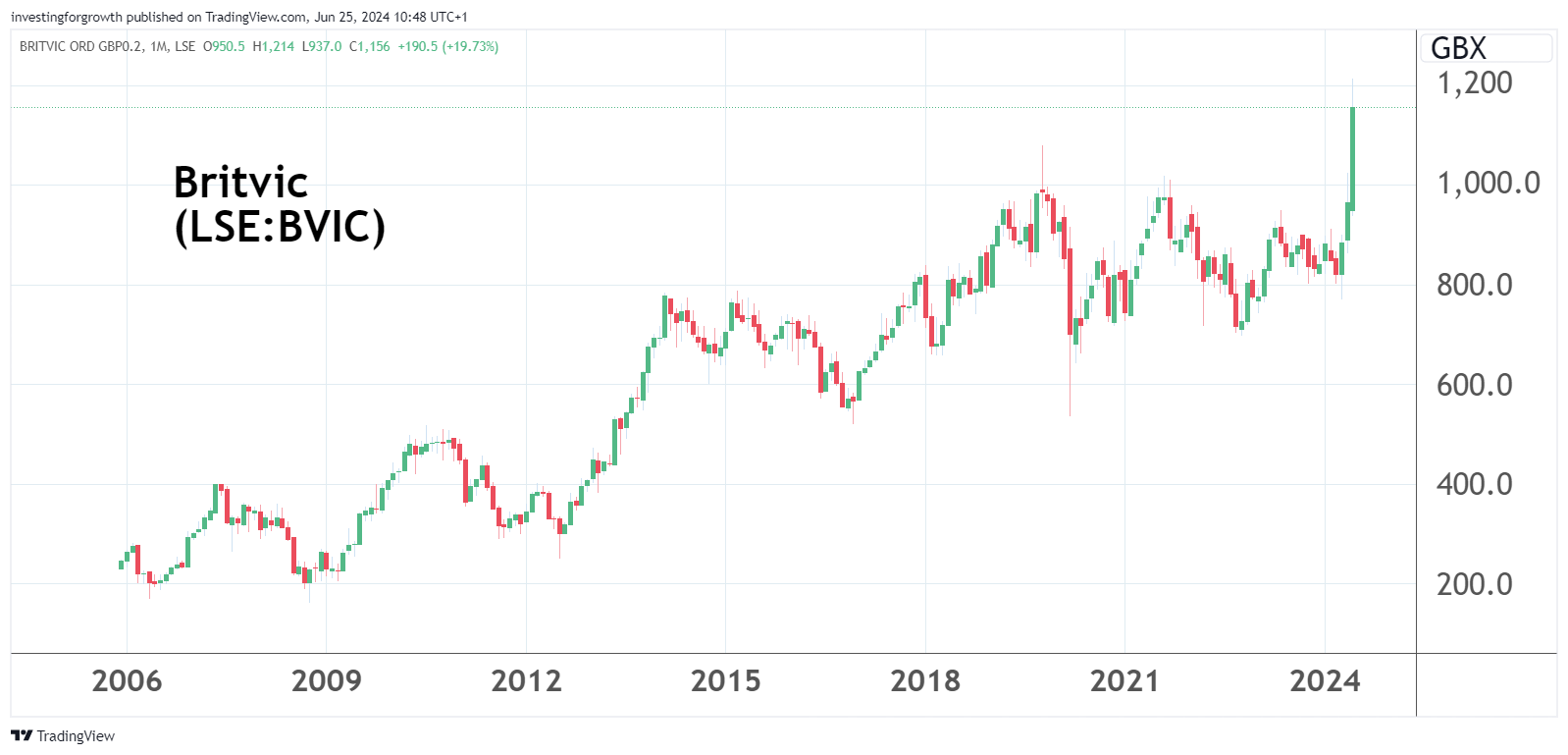Stockwatch: UK takeover interest shifts to quality consumer brands
A growing trend of overseas buyers acquiring British companies shows little sign of slowing down. Analyst Edmond Jackson gives his view of events at this FTSE 250 bid target.
25th June 2024 11:49
by Edmond Jackson from interactive investor

Carlsberg’s approaches to acquire FTSE 250 soft drinks group Britvic (LSE:BVIC) for £3 billion or so, show how international takeover interest in the London market now includes “quality at a fair price” stocks beyond those thought to be weakly valued.
- Invest with ii: What is a Managed ISA? | Open a Managed ISA | Transfer an ISA
In chart terms, it comes amid a sideways-volatile trend over recent years, although in a 20-year context there is a steady overall uptrend from around 250p.

Source: TradingView. Past performance is not a guide to future performance.
The 10-year track record shows reasonable, if modest, revenue and earnings growth, with decent double-digit operating margins and free cash flow despite high investment some years. Britvic’s twin dilemmas have been the sugar tax in the March 2016 budget, and Covid closing pubs and restaurants, which affected demand for premium non-alcoholic drinks.
| Britvic - financial summary | ||||||||||
| Year ending 30 Sep | 2014 | 2015 | 2016 | 2017 | 2018 | 2019 | 2020 | 2021 | 2022 | 2023 |
| Turnover (£ million) | 1344 | 1300 | 1431 | 1431 | 1504 | 1545 | 1412 | 1405 | 1618 | 1749 |
| Reported pre-tax profit (£m) | 120 | 138 | 152 | 139 | 146 | 110 | 111 | 135 | 175 | 157 |
| Normalised pre-tax profit (£m) | 136 | 148 | 152 | 138 | 160 | 110 | 111 | 135 | 175 | 157 |
| Operating margin (%) | 11.9 | 13.2 | 12.1 | 10.2 | 11.0 | 8.4 | 9.2 | 10.8 | 11.9 | 10.4 |
| Reported earnings/share (p) | 36.2 | 41.2 | 43.5 | 42.2 | 44.1 | 30.3 | 35.4 | 36.1 | 52.5 | 47.9 |
| Normalised earnings/share (p) | 42.7 | 45.3 | 43.6 | 41.8 | 66.1 | 63.7 | 54.0 | 44.1 | 54.9 | 63.8 |
| Cash flow/share (p) | 49.8 | 58.4 | 42.9 | 67.7 | 77.9 | 69.4 | 63.2 | 84.3 | 89.7 | 92.1 |
| Capex/share (p) | 23.3 | 22.9 | 44.0 | 49.0 | 54.1 | 28.0 | 18.7 | 24.9 | 31.7 | 30.1 |
| Dividend per share (p) | 20.9 | 21.5 | 23.3 | 26.5 | 28.2 | 30.0 | 21.6 | 24.2 | 29.0 | 30.8 |
| Covered by earnings (x) | 2.0 | 2.2 | 1.9 | 1.6 | 1.6 | 1.0 | 1.6 | 1.5 | 1.8 | 1.6 |
| Net tangible assets per share (p) | -87.8 | -35.7 | -52.1 | -43.9 | -23.6 | -5.2 | -11.0 | -1.6 | 30.0 | -16.9 |
| Source: historic Company Refs and company accounts | ||||||||||
More recently, there has been criticism about how gearing up the balance sheet meant interim results to 31 March showing the net finance charge took 16% of operating profit, although it is more a nuisance rather than problematic when operating profit rose 15%. This did however clip the net profit advance to 10% at near £60 million.
From its 2020 acquisition of Marston’s, Carlsberg is fourth in the UK brewing league although key brands such as San Miguel, Kronenbourg and Carlsberg seem consolidated at best.
My hunch is Carlsberg recognises long-term decline ahead in alcoholic drinks, while the variety of soft-drink alternatives continues to proliferate, with a host of respected consumer brands emerging. Buying Britvic thus offers radical strategic change in one go, the key question being, can this mark an industry first for integrating beer and soft drinks successfully?
Affirms the Warren Buffett consumer “franchise” concept
Buffett meant strong brands that engender people’s loyalty rather than the British sense of a franchisee operating a parent company’s business concept. It is best illustrated in his long-term stake in Coca-Cola Co (NYSE:KO), where there is a parallel in Britvic’s exclusive licence with PepsiCo Inc (NASDAQ:PEP) to make and sell Pepsi products in Great Britain and Ireland.
Possibly, Carlsberg also judged from the revenue details within Britvic’s first-half-year results, that it is time to act.
Family-favourite brands such as Robinsons and Tango performed well and there was stand-out growth from the likes of Pepsi MAX and Fruit Shoot, such that UK revenue rose nearly 9% and Ireland by 8%. Management sees strong potential to leverage Jimmy’s Iced Coffee, acquired a year ago, and the Plenish organic plant-based milks have nearly trebled revenue.
France improved significantly in the second quarter and Brazil has soared nearly 35%, with double-digit first-half growth where an acquisition has also introduced high-margin energy drinks. While that takes Brazil’s contribution only to 12% of group revenue, investment there was one key reason why I advanced the stock as a “buy” at 575p in 2017.
Back then, Britvic's earnings growth was nothing too exciting – just respectable single-digits at the per share level – albeit there was scope to enhance this, backed by a near-5% yield covered twice by earnings. Yet it seemed to me the group was at an inflection point operationally given scope to become a premium global brand in low/no sugar drinks – capitalising on a trend to supplant both alcohol and sugar. Alcohol consumption is declining especially among younger people and the proportion of teetotallers is rising in society.
- Sign up to our free newsletter for share, fund and trust ideas, and the latest news and analysis
- Insider: attractive entry point for investors, and directors
Benefits from an investment programme were also feeding through, hence my re-iterating to accumulate Britvic in early 2019 at around 860p as “one of the better quality defensive stocks.”
Ironically, the consensus of recent forecasts has targeted only 4% earnings per share (EPS) growth in this current financial year and near 10% to 73p in respect of September 2025. On that basis, and assuming a cash offer over 1,300p a share from Carlsberg (an increased proposal of 1,250p having been rejected as “significantly undervaluing” Britvic), the exit price/earnings (PE) multiple would be around 18x. This would hardly be expensive given possible scope to derive synergies, combining distribution channels and so on.
Carlsberg will be mulling this seriously
It is probably the best opportunity Carlsberg has to make a radical strategic leap into soft drinks – where the market is trending upwards.
Yesterday, Britvic shares rose 7% to 1,172p after a statement by Carlsberg it had reached agreement with PepsiCo where the latter has waived a “change of control” clause in bottling arrangements with Britvic. This will come into effect should Carlsberg complete the acquisition of Britvic by way of recommended offer.
It was justifiably interpreted as raising the odds of a deal yet, in truth, it’s the kind of thing a company board would request of its management anyway (while deliberating a next possible offer price). The PepsiCo bottling arrangement includes 7Up and Lipton Iced Tea, hence is axiomatic.
- Election manifestos 2024: the impact on your personal finances
- 10 hottest ISA shares, funds and trusts: week ended 21 June 2024
The behavioural crux looks to be whether a deal can be done at around 1,350p a share or higher, or the board holds out for more like 1,400p, causing Carlsberg to walk.
Britvic shares last breached 1,000p in late 2019 and only re-gained that after last May’s interim results. Even market highs have thus undervalued what a private owner is manifestly prepared to pay for the portfolio of brands; though you could say that Carlsberg’s sequence of possible offers this month, at a 20% then 25% premium to market price, affirmed a textbook business school approach for control.
Carlsberg’s board will be locked on the question about what extent of increased possible offer can be value-enhancing in the long run. From an operations perspective it looks like they are unanimously sold on integrating beer and soft drinks despite its uncertainties.
Finely balanced risk/reward profile for now
This is all about price, and Carlsberg has until 5pm on 19 July to declare whether or not it will make a firm offer. Meanwhile, the two companies and their advisers will continue negotiating, and a conclusion seems unlikely soon.
Easing to near 1,150p this morning, Britvic stock’s risk/reward profile looks balanced between possibly 20% up and 15% down (should Carlsberg retreat) if very hard to fathom the odds of a deal happening.
A speculative initial investment in Britvic therefore does not make sense to me, although the stock could drift further should this situation drag on a few weeks, in which case it is worth watching.
While the share price could fall below 1,000p in the short term on no deal, this approach has affirmed Britvic’s intrinsic value – hence the potentially more interesting trade is “buy the drop” as and when any speculative money has to clear. Hold.
Edmond Jackson is a freelance contributor and not a direct employee of interactive investor.
These articles are provided for information purposes only. Occasionally, an opinion about whether to buy or sell a specific investment may be provided by third parties. The content is not intended to be a personal recommendation to buy or sell any financial instrument or product, or to adopt any investment strategy as it is not provided based on an assessment of your investing knowledge and experience, your financial situation or your investment objectives. The value of your investments, and the income derived from them, may go down as well as up. You may not get back all the money that you invest. The investments referred to in this article may not be suitable for all investors, and if in doubt, an investor should seek advice from a qualified investment adviser.
Full performance can be found on the company or index summary page on the interactive investor website. Simply click on the company's or index name highlighted in the article.
Disclosure
We use a combination of fundamental and technical analysis in forming our view as to the valuation and prospects of an investment. Where relevant we have set out those particular matters we think are important in the above article, but further detail can be found here.
Please note that our article on this investment should not be considered to be a regular publication.
Details of all recommendations issued by ii during the previous 12-month period can be found here.
ii adheres to a strict code of conduct. Contributors may hold shares or have other interests in companies included in these portfolios, which could create a conflict of interests. Contributors intending to write about any financial instruments in which they have an interest are required to disclose such interest to ii and in the article itself. ii will at all times consider whether such interest impairs the objectivity of the recommendation.
In addition, individuals involved in the production of investment articles are subject to a personal account dealing restriction, which prevents them from placing a transaction in the specified instrument(s) for a period before and for five working days after such publication. This is to avoid personal interests conflicting with the interests of the recipients of those investment articles.